JAPAN
TRIP PHOTO ALBUM
Tokyo Religious
Sites
In Japan, religion is a way of thinking and relating
to the world and one's family. It is not about attending regular
services or reading scriptural text or "spreading the word." Japan
has two main religions: Shintoism and Buddhism. (Christianity represents
only 1% of the population.) Shintoism evolved in Japan from animistic
worship to all things in nature such as ancestors, stars, mountains, vegetables,
animals and national heroes. Confucianism entered the picture in the 5th
century with its importance on family and loyalty. Buddhism made
its way to Japan from India via China during the middle of the 6th century.
The most common sect of Buddhism in Japan is Zen which emphasizes a strictly
disciplined life style designed to rid one of desire, so that s/he might
achieve enlightenment.
The Japanese people have no conflict with having both Shintoism and Buddhism
in their lives because they feel that each has its place. As our
guide, Aiko Nitta san (of Kamakura) told us: "Shintoism takes care
of this world and Buddhism takes care of the next world."
Buddhism is represented in temples, and Shintoism is represented by shrines.
Often the two share the same vicinity side by side with no apparent conflict.
( Check bottom of this page of
links.*)
Check bottom of this page of
links.*)
Click on the photo for
a larger image

|
We visit the Hie Shrine in the Akasaka section of Tokyo. This
scene adds new meaning to the word "spirits" as sake is used for purification
in some Shinto ceremonies |
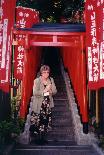
|
The back steps to the Hie Shrine were lined with dozens of these colorful
banners and presented a dramatic entrance (or exit depending on which way
you were going.) |
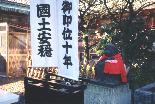
|
At the entrance to the Hie Shrine complex is a statue of a female monkey
holding a baby monkey. The monkey serves as the messenger to the
guardian god and is worshipped today for protection against miscarriage
and as a symbol of marital harmony. (from Frommer's Walking
Tours of Tokyo/Reiber) |

|
Here you can see a traditional torii gate at the Hie Shrine
compound. These gates always symbolize the separation between the everyday
world and the divine world. |
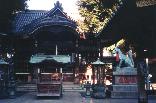
|
The main temple of Toyokawa Inari Betsuin in Akasaka, Tokyo.
You can see the spiritual fox with its red bib in the foreground right. |
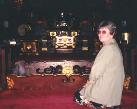
|
This is the altar to Benten, the goddess of music, wealth
and intelligence. It was here I got the really bad omikuji
(fortune paper) which, if I had known, I could have left it there in good
hands. Instead, I carried it in my pocket until I could find a translator.
Whoops! |
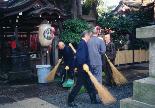
|
An early morning sweeping of the grounds around the Yuzu Inari Sonten,
the deity of wealth, is not a bad idea. |
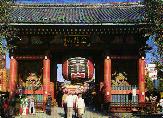
|
The Kaminarimon Gate where the gods of wind and thunder flank
the 1,500 pound lantern provide an impressive entrance to the lane leading
to the Sensoji Temple. (Postcard) |

|
Sensoji Temple is dedicated to Kannon, the Buddhist goddess of mercy.
This is Tokyo's oldest (founded in the 17th century) and most popular temple. |

|
This five-story red and gold pagoda is typical of Buddhist temples
in Japan. Each story symbolizes an element of the Buddhist universe.
At the top is sky, next wind, fire, water and finally earth. |
 *While
there are many Internet sites dealing with religion in Japan, here are
a few that I found interesting and useful:
*While
there are many Internet sites dealing with religion in Japan, here are
a few that I found interesting and useful:
Religion
in Contemporary Japanese Society (Asia Society)
"Religion" by
nihongo.org
A Tapestry
of Traditions: Japanese Religions
To Mrs. Wheeler's home page
To Photo Index Page
To Learning in Japan Page









